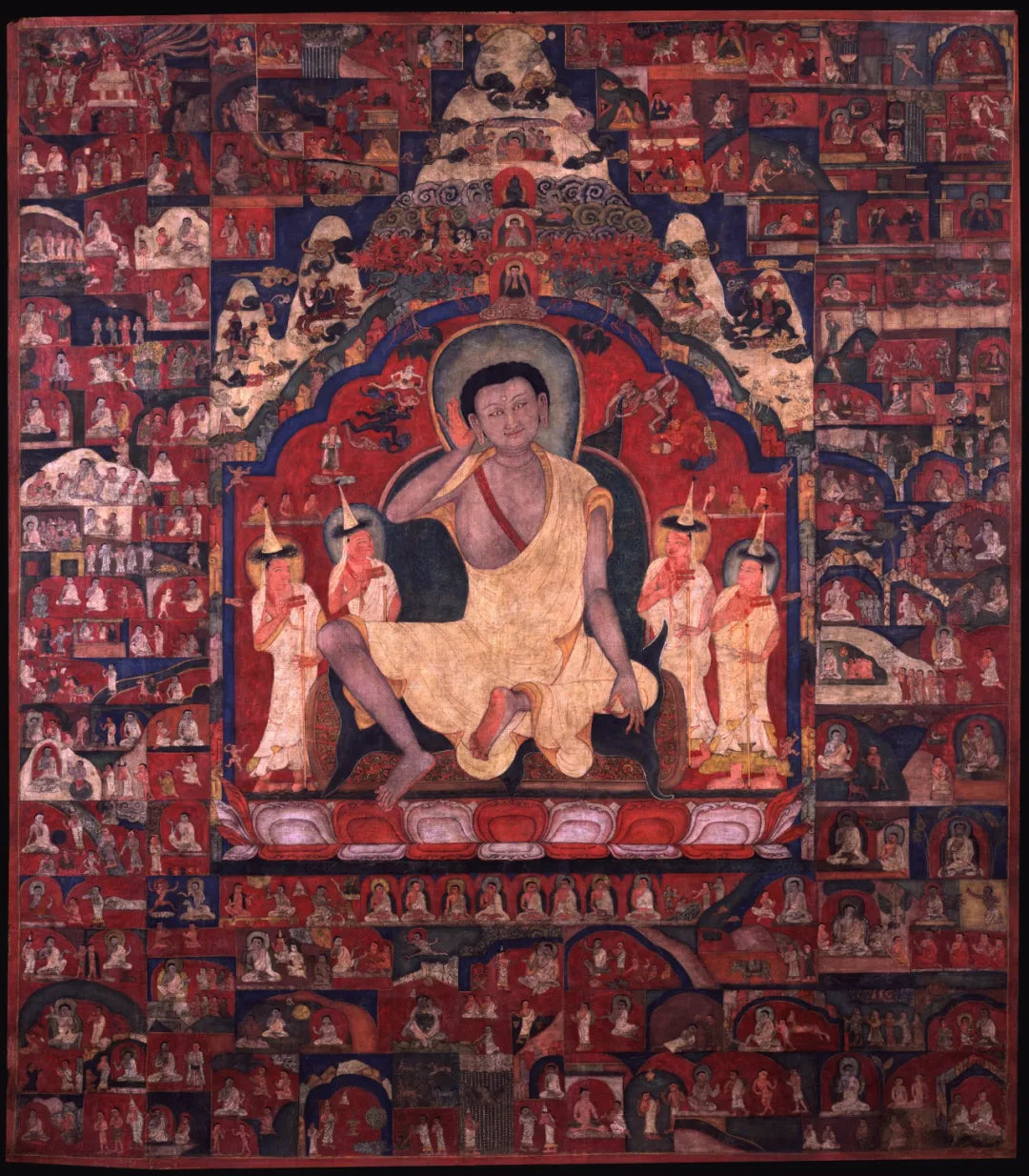
Wise Man's Crown : The Law Hat in Himalayan Art (Part One)

The hats not only distinguish their identities,
but also witness their glory as the wise men of the snowy land.


In the practice of Guru Yoga(བླ་མའི་རྣལ་འབྱོར་)of the Eighth Gyalwa Karmapa, he is surrounded by eight Dakinis.
Throughout history, the Gyalwa Karmapas have worn a black hat made from the hair of Dakinis, which is the most famous origin myth of the Tibetan tradition of wearing ceremonial hats.


Preface: the distinction between red and yellow.
Many years ago, Lume Tsering(ཀླུ་མེས་ཚུལ་ཁྲིམས་ཤེས་རབ་), the seeker of the Dharma, was about to leave his teacher, the great Tibetan Buddhist master, Lachen Gongba Ralse. This year was 978 AD. Before departing, Lachen gave Lume a special hat with ear flaps (some sources say it was a Bon-decorated white hat), and told him, "As long as you wear this hat, you will remember me."
This story about the origin of Tibetan ceremonial hats has been passed down in Buddhist communities for a long time. The tradition of using ceremonial hats to symbolize religious lineage is one of the reasons for the proliferation of various types of hats in Tibetan regions.


Particulars: The dark-colored fedora of Adi Gorge


In the image, I highlighted the image of Zhong Dunba.
The "long hair" signifies Zhong Dunba's special identity in his practice (between lay and monastic vows).
In his biography, Zhong Dunba is not allowed to wear a hat or head covering.

Rechungpa (རས་ཆུང་པ་; 1085-1161)
is an example for practitioners,
combining the traditions of native sorcerers and South Asian yogis.

with a pointed flag on top, made of fur and leather,
and with a sun and moon motif on the front, all reflecting the tradition

The background of the picture is Mount Kailash,
this is the place where Milarepa practiced.

holding Damaru drums(ད་མ་རུ་)and practice sticks,
following the voice of Milarepa,
chanting the teachings in song(མགུར་གླུ་).

"Tsongkhapa," 15th century, housed at the Rubin Museum of Art in New York.


There are a total of five images of masters,
Observing the two masters on the left,
They are wearing red and yellow hats respectively.

It could be Sradha Karavarma and Zadimba(བྲག་སྟེང་པ་).

The Yellow Hat sect had emerged.

Sakya 2nd Patriarch Sönam Gyaltsen Mö (བསོད་ནམས་རྩེ་མོ་;1142-1182):
"Some people say it was transmitted from the Lakṣmi tradition,
while others say it was transmitted from the Tupa Yeshé Jampal tradition."
Concept
What is a Law Hat (བླ་ཞྭ་-དགེ་ཞྭ་-དབུ་ཞྭ་)? Perhaps this question is a real challenge for scholars studying Tibetan Buddhism. If we place this question in the context of early Buddhism development, we will find that the act of covering the head by monks was mostly for protecting the head from cold or as a privilege for those with health issues. The Vinaya texts allowed monks to use fine hair and cotton to make "head coverings" for daily rest or travel, but not for religious rituals or practice. It is important to distinguish between the various crowns worn by deities and the Law Hats worn by monks, as this relates to the distinction between the sacred and the secular.


The first native South Asian traditional Banabhatta




Partial: Five Patriarchs of the Saṃgha
In early images, only Saban wore hats.
In South Asian traditions, the title of Pandita can be acquired by mastering the Dvividha Shastra (no matter Buddhist or any Indian denomination). According to the method combining literature and imagery, we can identify two types of classification of the Pandita hat peculiar to Tibet. An interesting source of information comes from the Persian historian Minhaj-i-Siraj (12-13th century). Minhaj-i-Siraj recorded the persecution of Buddhist temples and monks by Turkic Muslim armies. He documented the slaughtered monks, saying, "Those shaven-headed Brahmans (referring to monks) were all killed, some were students, others were teachers wearing red hats" (author's translation). Here we can see that the red hat (possibly the Pandita hat) not only served as a headgear but also had the function of distinguishing identity, namely that those who wore red hats were Buddhist scholars with educational functions.






The "Four Major and Eight Minor" sects of the Gelug school all stem from the teachings of Tsongkhapa. Although each sect has made some modifications, Tsongkhapa's Ganden Trikor (Ganden hat with earflaps) remains the most important practice hat in the Gelug school.


The Tibetan inscription behind the sculpture reads "Tashi Delek Dawa Gyuno (meaning Gangpooba)."
The research on the ceremonial hat fundamentally involves discussions on sects (གྲུབ་མཐའ་), highlighting the differences in doctrines and lineages. As stated in the literature, "ཞྭ་དང་སྲུང་མར་མཁས་ན་སྒྲུབ་བརྒྱུད་ལ་མི་རྨོངས། (Understanding the distinction between ceremonial hats and protectors will dispel any confusion regarding sectal transmissions)." In specific studies, ceremonial hats serve as one of the best elements to differentiate religious figures. As long as the categories of ceremonial hats are not confused, one can roughly decipher the lineage and sect of the core figure in an image even without textual assistance. Therefore, after grasping the essence of ceremonial hats, it becomes crucial to establish effective classifications for them. In the next article, we will explore a method for effectively classifying ceremonial hats and delve into the different "origin myths" behind them.

